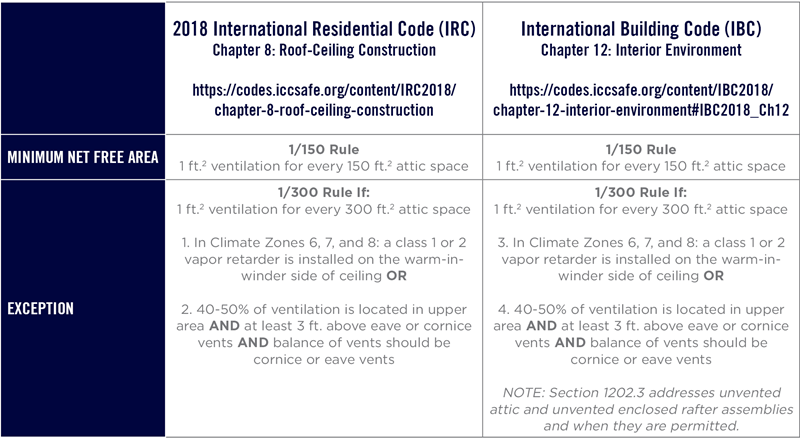In our last blog post we went over the different types of ventilation for sloped roofs and requirements. In this blog we will discuss how to calculate the proper information in order to select the right products to use on your building projects.
A Balanced Ventilation System
A balanced ventilation system is vital to the longevity or your roof and building. Every inch of exhaust air requires an equal or greater amount of intake air. Intake and exhaust vents should be installed with equal amounts of Net Free Area (NFA). NFA: The amount of total unobstructed area that will allow air to enter or exhaust a vent system.
Building Code Requirements (Commercial vs. Residential)
Commercial and residential building code requirements are actually very similar. However, commercial buildings are usually much larger and require a greater amount of ventilation.

The calculation needed for an attic ventilation system determines the amount of air space.
(af/300) x 144/LF= Inches2 of NFA/LF
(This calculation needs to be run once for the LF of eave and again for the LF of ridge)
-
af = Attic Floor Square Footage
-
LF = Lineal Feet of Eave or Ridge (run calc separately for eave & ridge)
-
NFA = Net Free Area
-
NOTE: Based on the 1/300 rule for attic ventilation. For more conservative results based on the 1/150 rule, multiple the results by 2.
Metal-Era has a great resource to help you calculate your attic ventilation requirements…
Attic Ventilation Calculator
The Attic Ventilation Calculator will help you calculate the Net Free Area for your project and the necessary vent width for your ridge vents or vented fascia products. Please enter either the square feet of attic space or the NFA that your project requires and the vented eave and ridge length.
Vented Nailbase Calculator
When there is no attic space to ventilate, it creates some unique challenges to establish a balanced ventilation system. The 1/300 rule does not apply here. For vented nailbase ventilation systems you need an air gap between 1-2 inches. The overall idea of the vented nailbase system is to exhaust the same amount of air you are taking in.
Metal-Era has a calculator that can help you determine the proper air gap…
-
Cold Regions: the right air gap and insulation R-value will prevent ice daming
-
Warm Regions: the right air gap and insulation R-value will keep your roof cooler to prevent your shingles from curling and prolong the life of your roof
Our Vented Nailbase Ventilation Calculator takes in account R-value of insulation and slope or the roof which effects how fast the air exhaust. Your air gap and R-value of insulation can be adjusted to create the proper ventilation to get a balanced roof system/cool roof system (preventing ice dams).
Metal-Era has of sloped roof ventilation products for a wide variety of room types and backed by one of the industry’s best wind and ventilation warranty.
Examples:
-
If you have a 10 ft. length and you take in 12 NFA per foot (1” Ridge Opening)
-
120 square inches of air/NFA exhaust through ridge (1:1 eave to ridge ratio – this would be a single pitched roof)
-
5 ft. ridge length you still need to exhaust 120 NFA (2” Ridge Opening) (2:1 eave to ridge ratio – this would be a roof that has pitch on both sides, typically a gable roof)
Sources:
Metal-Era Principles of Commercial Ventilation AIA Slides
https://codes.iccsafe.org/content/IRC2018/chapter-8-roof-ceiling-construction
https://codes.iccsafe.org/content/IBC2018/chapter-12-interior-environment#IBC2018_Ch12